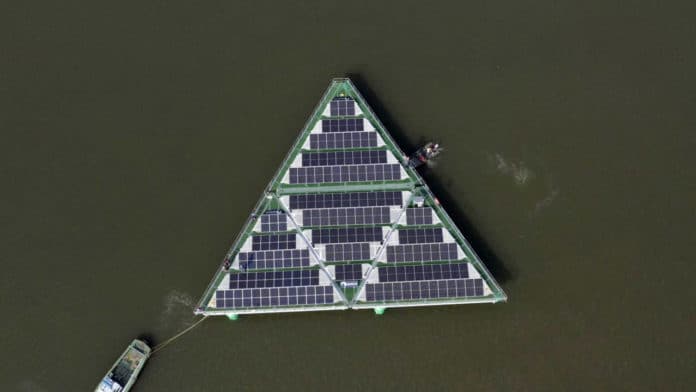The world is focused on seeking cleaner, cheaper, more efficient energy and that can be used in most parts of the planet without many limitations. With that in mind, a new project is being developed in the Netherlands that promises to revolutionize the offshore solar energy market and could contribute to the process of replacing fossil fuels.
A Dutch startup SolarDuck has developed a triangular offshore floating solar power platform that will be towed to the open sea to make the most of sunlight to generate clean energy. Called the “Demonstrator,” the platform was recently towed upriver in the Netherlands to simulate some of the wind and water stresses of being out at the open sea, and the results were great.
SolarDuck has engineered the floating solar power platform to withstand coastal sea conditions and hurricane-force winds but has also optimized them for offshore sites in estuaries, natural harbors, as well as near-shore sites, overcoming the waves more than 3 meters (10 ft) high and hurricane winds. The upriver test saw a triangular solar farm dragged 31 miles (50 km), experiencing forces of 17.6 tons (16 metric tons) while moving at 7 knots.

The installation consists of four triangular platforms fitted with 39 solar panels each, which are mounted on floating supports. The aluminum structure holds the solar panels and electrical parts more than three meters above the water level. Each of its three sides is about 16 meters long.
The company will deploy its first real offshore PV plant on the Waal, a major waterway connecting the port of Rotterdam to Germany. The project will have a total installed capacity of 65 kW and will be connected to a 10 kW electrolyzer operated by Voyex, reports PV magazine.
“The idea is based on our offshore heritage,” said CEO SolarDuck Koen Burgers in a PV Magazine report. “It is more or less a semi-sub structure that is used in offshore floating wind projects. What we did was connecting these platforms in a smart way, and by elevating the platforms, you get much less wave resistance.” Despite the similarity with offshore wind platforms, the floating structure is claimed to be much lighter. Besides, the distance from the water surface ensures that the modules and other components stay dry.
The company is currently aiming at building standard projects with a capacity of 10 MW, but projects of this size may eventually be grouped and form floating complexes of up to 500 MW peak power output. In a promotional video, SolarDuck offered more details on the floating solar Demonstrator’s recent upriver test.
Considering the accelerating impacts of climate change, the arrival of Demonstrator is at the right time. Solar energy is by far the cheapest method to produce renewable energy in the sunbelt, where sunlight is abundant, but the wind is not. Unfortunately, many cities do not have the conditions to build solar farms that would be able to generate enough energy. Floating platforms can change that. With this in mind, SolarDuck is already thinking about building the next Demonstrator solar farm variant, which will be up to 13 times the size of the one tested in the Netherlands.
